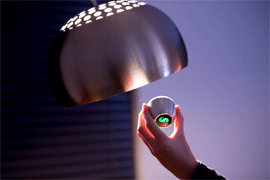The smart lighting market which consists of control and communication systems and luminaires is expected to be reach more than USD 8billion by 2020 with a CAGR of nearly 22% between 2015 and 2020. North Americas contributes to the largest market share in 2015 but APAC region is expected to grow at higher grow rate of nearly 30% during the forecast period, according to MarketsandMarkets.
 Although wired solutions for connected lighting has been the most popular approach for installing smart lighting systems, there has been a considerable work and interest in development of wireless solutions for smart lighting based on protocols such as EnOcean and Zigbee. These protocols are expected to hold a significant chunk of the market till 2020. Another major trend in the market is growing use of LED lights as the major light sources. As per MarketsandMarkets, majority of the installed smart lighting systems by 2020 will be using LED as the lighting source.
Although wired solutions for connected lighting has been the most popular approach for installing smart lighting systems, there has been a considerable work and interest in development of wireless solutions for smart lighting based on protocols such as EnOcean and Zigbee. These protocols are expected to hold a significant chunk of the market till 2020. Another major trend in the market is growing use of LED lights as the major light sources. As per MarketsandMarkets, majority of the installed smart lighting systems by 2020 will be using LED as the lighting source.
Smart Lighting Current Trends and Future Opportunities and Challenges
Currently, the Fluorescent lighting is the commonly used lighting source with smart lighting systems. This trend is expected to shift toward LED lighting by 2020 as they consume lower energy as compared to other lighting sources and also there has been a significant decline in prices of LED in recent years.
The greater emphasis on reducing energy consumption and increasing environmental sustainability has been the primary driver of growth in Smart Lighting market. Within the buildings Lighting systems are biggest consumers of energy contributing to almost 35% to 40% of overall energy spend of a building, so an energy efficient lighting system is a pre-requisite for a greener infrastructure.
Second major push factor for smart lighting has been emergence of IoT and convergence of IoT with building and lighting systems. Although a general lighting system based on LED Source can save energy, but a connected lighting system consisting of sensor systems provides a much higher energy saving. Even in developing countries such as China and India, there has been a considerable interest and efforts put in by governments for development of modern urban infrastructures such as “Smart Cities”, which will encompass an eco-system of connected devices and systems including smart buildings and smart public lighting systems used on roadways and streets.
One of the major roadblocks in implementation and adoption of smart lighting system has been the lack of standardization of communication protocols among various lighting systems developed by manufacturers which curtails the interoperability within systems. For example a lighting system developed to operate on DALI which is most used technology in Europe may not of much use in U.S. where BACnet seems to be a preferred lighting communication protocol. Furthermore there are many manufacturers who develop and implement systems using their in-house proprietary communication protocols. A universal communication protocol which would provide interoperability for systems designed by various manufacturers is the need of the hour.






